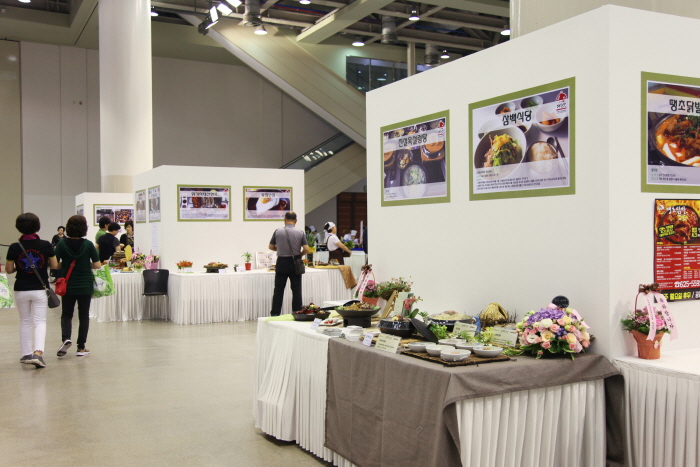E-Mart - Gwangmyeong Soha Branch [Tax Refund Shop] (이마트 광명소하)
13.3Km 2024-04-22
97, Soha-ro, Gwangmyeong-si, Gyeonggi-do
-
Himart - Soha Branch [Tax Refund Shop] (하이마트 소하점)
13.3Km 2024-04-18
506, Ori-ro, Gwangmyeong-si, Gyeonggi-do
-
Goyang West Three Royal Tombs (The tomb of Queen Janggyeong) [UNESCO World Heritage] (고양 서삼릉(장경왕후) [유네스코 세계문화유산])
13.3Km 2024-02-07
233-126 Seosamneung-gil, Deogyang-gu, Goyang-si, Gyeonggi-do
+82-31-962-6009
Goyang West Three Royal Tombs is a significant historical site comprising three major royal burial grounds in the western area. Huireung Royal Tomb is dedicated to Queen Janggyeong (1491-1515), the consort of King Jungjong during the Joseon dynasty. Hyoreung Royal Tomb is the resting place of King Injong (1515-1545) and his queen, Inseong. Yereung Royal Tomb holds the remains of King Cheoljong (1831-1864) and his queen, Cheorin. This area is home to numerous tombs and relics belonging to various members of the Joseon royal family.
Universal Arts Center (유니버설아트센터)
13.3Km 2024-03-19
664 Cheonho-daero, Gwangjin-gu, Seoul
Universal Arts Center, inaugurated in 1981, stands as a prominent venue for performances. Renowned for its splendid and classic architectural interior, it is celebrated for its distinctiveness. Its main facilities include the Grand Theater, the Luna Hall capable of accommodating up to 300 guests for banquets, and an audience lounge. It serves as a harmonious space where performance venues, artistic community, and art educational institutions converge. Here, visitors can enjoy a diverse array of performances ranging from ballet and musicals to concerts.
Taerim Sanchaejeongsik (태림 산채정식)
13.3Km 2021-03-30
32, Nohae-ro 60-gil, Dobong-gu, Seoul
+82-2-998-5468
This restaurant is famous for its dishes of wild vegetables, Deodeok and roots of balloon flowers.
Grilled sliced pork comes with Table d’hote of assorted wild vegetables and grilled Deodeok, and is also very tasty. Water kimchi made from mineral water is deliciously spicy as well.
*Best Korean Restaurant as designated by The Seoul Metropolitan Government
Korea Food & Tourism Expo (한국음식관광박람회)
13.3Km 2021-09-17
27, Gangnam-daero, Seocho-gu, Seoul
• 1330 Travel Hotline: +82-2-1330 (Korean, English, Japanese, Chinese) • For more info: +82-2-737-2210
Seeking to become better and more advanced every year, the Korea Food & Tourism Expo offers a wide array of hands-on experience programs and seminars on food culture. Those hoping to participate in contests or special exhibitions should sign up on the festival website. For more information on the festival schedule, please see the website or call festival organizers using the number provided.
Seoul Doseonsa Temple (도선사(서울))
13.3Km 2025-06-25
504 Samyang-ro 173-gil, Gangbuk-gu, Seoul
Doseonsa Temple was established 1,100 years ago during the latter part of the Silla Kingdom when the renowned Buddhist priest Doseonguksa was traveling through the mountains. After visiting the site, Doseonguksa made a prophecy that led to the construction of the temple. According to legend, he used only his walking stick to carve the large Bodhisattva that sits at the temple. Interestingly enough, the statue does not show any evidence of chisel marks, further adding to the mystery of how the statue was made.
During the 7th year of King Gwangmu of the Joseon dynasty, Doseonsa Temple was officially named the representative temple of Korea with the purpose of promoting Cheongdamdaejongsa's Korean Buddhism movement, aiming at a religious revival. Due to these special circumstances Deseonsa Temple gained a high reputation and much recognition, which have held strong to this day.
Inside the temple, visitors can view the remains and written works of Cheongdamdaejongsa in the Cheongdamdaejongsa Memorial Hall. Next to the road leading to Cheonbuljeon Hall is a pond where you can toss a coin and make a wish and just past Yongammun Gate is a hiking path connecting Baegundae Cliff and Insubong Peak. Inside the Ksitigarbha Hall are portraits of President Park Chung-hee, Yuk Yeong-su, and Hyundai Chairman Chung Ju-yung. In front of the hall is a tree that is said to have been planted by a Buddhist priest who brought it from India 200 years ago. Historical artifacts can be found throughout the temple.
E-Mart Traders - Wolgye Branch [Tax Refund Shop] (이마트트레이더스 월계)
13.4Km 2024-04-17
15, Madeul-ro 3-gil, Nowon-gu, Seoul
-
E-Mart - Wolgye Branch [Tax Refund Shop] (이마트 월계)
13.4Km 2024-04-22
15, Madeul-ro 3-gil, Nowon-gu, Seoul
-
Bukhansan Dulle Trail Section 1 ([북한산 둘레길] 1 소나무숲길 )
13.4Km 2024-01-04
12 Samyang-ro 173-gil, Gangbuk-gu, Seoul
Bukhansan Mountain is a mountain representing Seoul, which 5 million people visit every year. It is not easy to hike up to the top, but the dulle trail allows one to enjoy the beauty of the mountain without too much effort. Bukhansan Dulle Trail is a low-lying, horizontal walking trail created by connecting and refining existing side paths, allowing for a leisurely walk along the foot of the mountain. The Pine Forest Trail, one section of the trail consisting of 21 themes, is 2.9 kilometers long from the entrance to Uiryeong Trail to the top of Solbat Neighborhood Park. It is filled with majestic pine trees, and the road is wide and gentle, making it a perfect place to enjoy a walk. Most of the section is shaded by trees, so visitors can feel cool while walking up even on hot summer days.
![E-Mart - Gwangmyeong Soha Branch [Tax Refund Shop] (이마트 광명소하)](http://tong.visitkorea.or.kr/cms/resource/38/2881838_image2_1.jpg)
![Himart - Soha Branch [Tax Refund Shop] (하이마트 소하점)](http://tong.visitkorea.or.kr/cms/resource/41/2881841_image2_1.jpg)
![Goyang West Three Royal Tombs (The tomb of Queen Janggyeong) [UNESCO World Heritage] (고양 서삼릉(장경왕후) [유네스코 세계문화유산])](http://tong.visitkorea.or.kr/cms/resource/85/1150385_image2_1.jpg)


![E-Mart Traders - Wolgye Branch [Tax Refund Shop] (이마트트레이더스 월계)](http://tong.visitkorea.or.kr/cms/resource/74/2888274_image2_1.jpg)
![Bukhansan Dulle Trail Section 1 ([북한산 둘레길] 1 소나무숲길 )](http://tong.visitkorea.or.kr/cms/resource/30/1898430_image2_1.jpg)
 English
English
 한국어
한국어 日本語
日本語 中文(简体)
中文(简体) Deutsch
Deutsch Français
Français Español
Español Русский
Русский